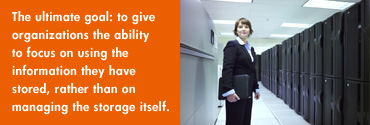
by Anne Stuart
For something with no physical properties, information certainly
takes up a lot of storage space. And that same intangible
asset generates plenty of very real headaches. Businesses
of every size know all too well about the difficulty of managing
an amorphous resource that, worldwide, is growing by nearly
30 percent a year.
Not surprisingly, there’s widespread demand for a
safe, effective and relatively inexpensive way to house all
that data – ideally, a solution that can expand in
a snap as a company’s information-storage needs multiply.
HP Labs researchers are working on an answer that could
replace the inflexible storage systems of today with a modular
system, designed to quickly accommodate a fast-growing organization's
changing storage needs.
"Traditional storage systems are large, monolithic
and expensive," says Alistair Veitch, a researcher in
the HP Labs Storage Systems Department. "Every manufacturer
has multiple product lines. They’re targeted to different
market segments and different specialties. Often, you’ve
got separate teams designing separate product lines, and
none of them use the same hardware and software."
As a result, when customers outgrow one storage system,
they typically must start over as they move up to the next
one.
HP already offers a relatively standardized approach provided
via its next-generation storage architecture, the HP StorageWorks
grid, which uses some elements of the lab's modular, system
The ultimate goal: to give organizations the ability to
focus on using the information they have stored, rather than
on managing the storage itself.
Researchers began work on what became their modular system
about three years ago.
"We looked at whether we could build a system that
would scale from the low end to the high end and have all
the features that you want," says Veitch, senior technical
lead and project manager. "We asked whether there’s
some way we could use off-the-shelf hardware and software,
rather than following the expensive, time-consuming tradition
of customizing new technology for each new product line," Veitch
continues. "And," he adds, "we looked at whether
we could make that system for less money."
Based on the team's ongoing work on the project, the answer
to all of those questions appears to be "yes." Essentially,
their system relies on small, rack-mounted storage appliances
consisting of disks, CPUs, storage adapters and network cards.
Together, each of these constitutes one modular storage unit
called a "brick" or "smart cell."
Cells can be added as needed. "By adding more cells,
you get more capacity and performance," Veitch says.
A software program "glues" cells together so they
function like a single array, or, as Veitch puts it, "one
very large pool of storage" that can be allocated as
needed. The storage load is automatically rebalanced whenever
units are added or subtracted.
The result: a storage system that, unlike traditional disk-array
storage systems, scales quickly and easily in response to
demand. IT administrators can either automatically or manually
deploy, expand or reconfigure their storage systems without
disrupting service or affecting performance. And they can
do so at relatively little expense because the use of common
hardware components keeps costs down.
Upgrades of the product line are easy, notes Beth Keer,
storage systems department manager. "You can adapt to
changes in technology over time – improvements in interconnects,
for instance – fairly rapidly."
Researchers initially worried that their ideas might represent
too dramatic a departure from traditional storage systems.
"We thought there might be a little psychological resistance
to something that looks so foreign," Keer says. "But
because of its scalability, it actually has a familiar feel."
Upgrades of the product line are easy, notes Beth Keer,
storage systems department manager. "You can adapt to
changes in technology over time – improvements in interconnects,
for instance – fairly rapidly."
Like many teams at HP Labs, the group is both international
and multi-disciplinary. Each of its nine members represents
a different country and a variety of technical areas. (Veitch
is from New Zealand; Keer was born and raised in the United
States and other team members hail from Argentina, Brazil,
Denmark, Greece, India, Japan and Scotland.) Researchers'
technical specialties encompass a lot of territory as well,
and include distributed systems, availability, performance,
algorithm design, modeling, engineering, code writing, operating
systems, networking and storage.
That breadth of experience and knowledge helped them tackle
the numerous technical challenges they faced in developing
their solution.
One problem had to do with addressing component failures,
which required replicating the data between cells. But incorporating
backup protection into systems is a complex undertaking involving
some tradeoffs, Veitch says. "Designing in hardware
redundancy adds a lot to the costs and complicates the software."
Ultimately, the team struck the right balance, designing
their solution to respond even better to failure than standard
storage systems. When a piece of hardware on a traditional
disk-array system fails, that system typically loses a large
percentage – often half or more -- of its performance
capability. But with the HP Labs system, if one component
fails, the others take over, allowing the system to function
with little or no loss of performance. Administrators can
also easily remove and replace malfunctioning hardware.
The team built its prototype using standard rack-mounted
servers. Because of the limited number of disks supported
by these first systems, the team is now experimenting with
newer designs that will incorporate larger numbers (up to
12 disks) in a single compact package.
One of the advantages of the experimental architecture is
that various aspects of the hardware are flexible -- you
can have a cell that has relatively more disk drives per
CPU units, for instance, which would be more appropriate
for bulk or archival storage. Other cells may have more memory
for higher performance.
"What’s exciting now is the huge opportunity that’s ahead
of us,” she adds, "both in terms of the business engagements
and all the research threads we can explore. It’s probably
more than we have the time and resources to do, so we need
to prioritize. But that’s a good position to be in."
Efficiently handling such heterogeneity is another key research
area. Veitch anticipates that cells will come in a variety
of storage sizes -- from smaller, four-disk models containing
a few hundred gigabytes at the entry level, to about a dozen
or more drives containing up to a few terabytes.
To add additional storage, "You just plug in a cell
and connect it to the network," Veitch says. "Then
you go to your management console, where you’re looking
at the whole system. You’ll see how just how much useable
space is there."
The Labs experimental solution also uses different methods
of replicating data to make sure it’s always available,
such as using an algorithm that provides mirroring of data
in three locations. "That way, if one fails, the other
two can carry on quite happily," Veitch says.
Although some HP StorageWorks grid products now use early
versions of smart-cell technology, the HP Labs team continues
developing the concept.
Current experiments involve increasing system scale. "Right
now, we can scale to 20 or 30 cells," Veitch says. "We’d
like to go beyond that and build some really big systems."
How big? The team envisions architectures one day containing
hundreds, perhaps thousands of cells – enough to build a
virtual warehouse big enough to meet the storage needs of
even the most prolific business.
|


